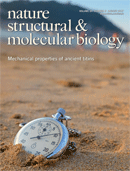TABLE OF CONTENTS
|
August 2017 Volume 24, Issue 8 |
 |  |  |
 |  News and Views News and Views
 Review Review
 Articles Articles | |
 |
|
 |
 |
Advertisement |
 |
HIV IMMUNITY AND ERADICATION,
A HERRENHAUSEN SYMPOSIUM
November 2-3, 2017 | Hanover, Germany
REGISTER NOW! |  | |
 |
| |
News and Views |  Top Top |
 |
 |
 |
|
 |
Articles |  Top Top |
 |
 |
 |
PAR-TERRA directs homologous sex chromosome pairing pp620 - 631
Hsueh-Ping Chu, John E Froberg, Barry Kesner, Hyun Jung Oh, Fei Ji et al.
doi:10.1038/nsmb.3432
New analyses reveal that TERRA transcripts arising from the subtelomeric pseudoautosomal (PAR) region of sex chromosomes nucleate pairing of X alleles in mouse ES cells.
See also: News and Views by Krivega & Dean |
 |
 |
 |
Asparagine endopeptidase cleaves α-synuclein and mediates pathologic activities in Parkinson's disease pp632 - 642
Zhentao Zhang, Seong Su Kang, Xia Liu, Eun Hee Ahn, Zhaohui Zhang et al.
doi:10.1038/nsmb.3433
Asparagine endopeptidase (AEP) cleaves human α-synuclein at Asn103, yielding a fragment with higher aggregation propensity than that of the full-length protein. Truncated α-synuclein is also more neurotoxic and leads to dopaminergic neuronal loss and motor impairments in mice. |
 |
 |
 |
Regulator-dependent mechanisms of C3b processing by factor I allow differentiation of immune responses pp643 - 651
Xiaoguang Xue, Jin Wu, Daniel Ricklin, Federico Forneris, Patrizia Di Crescenzio et al.
doi:10.1038/nsmb.3427
The structure of C3b in complex with factor I and a shortened version of factor H, along with functional analyses, leads to a mechanistic model for how regulators determine sequential cleavage events on C3b. |
 |
 |
 |
Mechanochemical evolution of the giant muscle protein titin as inferred from resurrected proteins pp652 - 657
Aitor Manteca, Jorg Schonfelder, Alvaro Alonso-Caballero, Marie J Fertin, Nerea Barruetabeña et al.
doi:10.1038/nsmb.3426
Single-molecule spectroscopy analyses of titin fragments from modern animals and reconstructed from the last common ancestors to mammals, sauropsids and tetrapods shed light on the evolution of the mechanical properties of muscle titin from the Paleozoic to our days. |
 |
 |
 |
Multi-domain utilization by TUT4 and TUT7 in control of let-7 biogenesis pp658 - 665
Christopher R Faehnle, Jack Walleshauser and Leemor Joshua-Tor
doi:10.1038/nsmb.3428
Structural analysis of the uridyl transferases TUT4 and TUT7 reveals the use of two functional modules in the switch from monouridylation of pre-let-7, which promotes let-7 expression, to oligouridylation of pre-let-7, which marks it for degradation. |
 |
 |
 |
A two-helix motif positions the lysophosphatidic acid acyltransferase active site for catalysis within the membrane bilayer pp666 - 671
Rosanna M Robertson, Jiangwei Yao, Stefan Gajewski, Gyanendra Kumar, Erik W Martin et al.
doi:10.1038/nsmb.3436
The crystal structure of Thermotoga maritima lysophosphatidic acid acyltransferase reveals a two-helix motif that positions the active site for catalysis within the membrane bilayer. |
 |
 |
 |
Musashi 1 regulates the timing and extent of meiotic mRNA translational activation by promoting the use of specific CPEs pp672 - 681
Laure Weill, Eulàlia Belloc, Chiara Lara Castellazzi and Raúl Méndez
doi:10.1038/nsmb.3434
New data reveal how Musashi binding to Xenopus oocyte mRNAs promotes changes in RNA secondary structure that modulate CPEB1 binding and influence polyadenylation and translational efficiency.
See also: News and Views by Lasko |
 |
 Top Top |
 |
 |
 |  |  |  |  |  | Natureevents is a fully searchable, multi-disciplinary database designed to maximise exposure for events organisers. The contents of the Natureevents Directory are now live. The digital version is available here.
Find the latest scientific conferences, courses, meetings and symposia on natureevents.com. For event advertising opportunities across the Nature Publishing Group portfolio please contact natureevents@nature.com |  |  |  |  |  |
|
 |


No comments:
Post a Comment